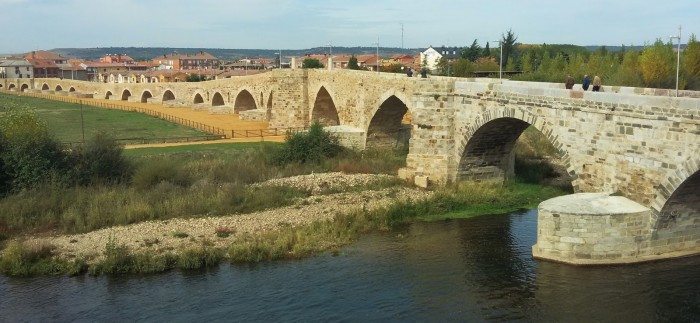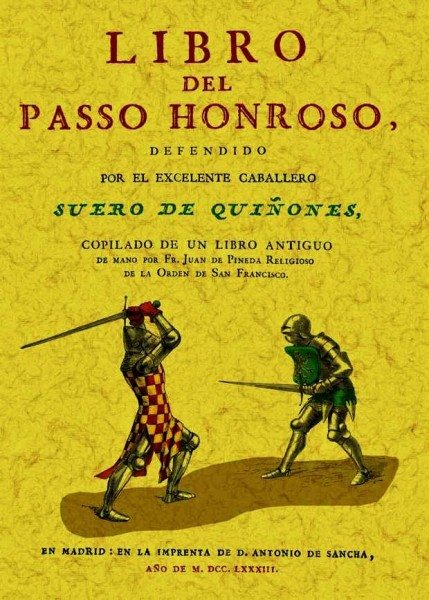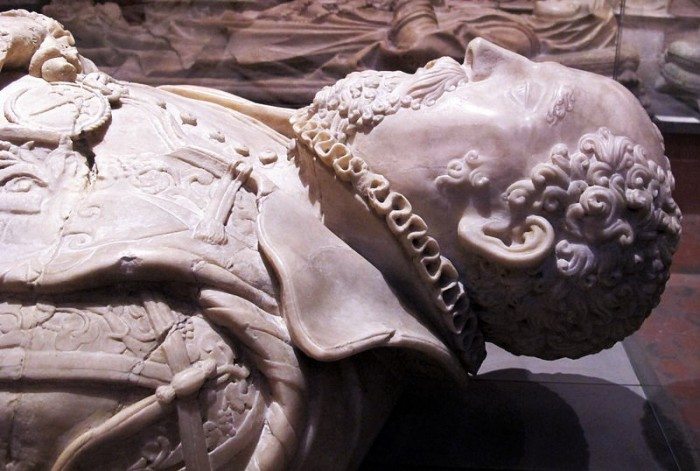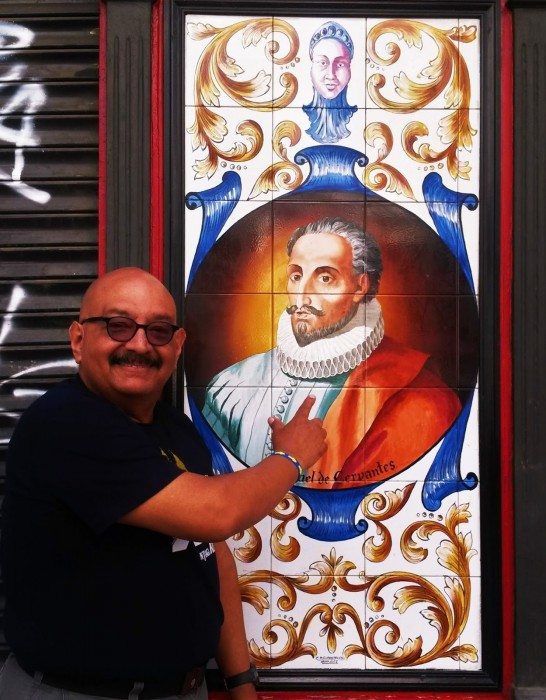Nearly 600 years ago, in the community of Hospital de Órbigo along the Camino de Santiago, one of the greatest publicity stunts of medieval Europe took place. Don Suero de Quiñones, a knight from the city of León, challenged knights everywhere to attempt to cross the bridge that enters the town. Challengers would be mounted on a horse and use a lance as their only weapon. Don Suero and nine of his friends would defend the passage, also mounted and with a lance. The defenders vowed to hold the bridge until they broke 300 rival lances. At that point, they would be declared victors of the tournament.
Don Suero’s stated motive for undertaking the bridge’s defense was that only in victory would he become free of his obsession over Doña Leonor de Tovar. Every Thursday he wore an iron collar around his neck to represent the prison in which she held his heart, and he claimed to be in unbearable pain over this unrequited love.
Organizing the tournament took months, and it counted with the full support and sponsorship of King Juan II of Castile. Sixty-eight knights from throughout Europe responded to the challenge, which became known as the defense of El Paso Honroso (The Path of Honor). From July 10 through August 9 of 1434, Don Suero and his nine companions defended the bridge. On the final date, with every defender including Don Suero suffering from serious injuries, but without a single challenger having crossed the bridge, the judges declared him victorious and free of the burden of wearing the iron collar.
King Juan II had appointed a scribe, the notary Pero Rodríguez de Lena, to record the details of the month-long tournament. One hundred years later, a Franciscan priest, Juan de Pineda, transcribed the proceedings into an engaging narrative, El Libro del Passo Honroso, which helped extend Don Suero de Quiñones’s legend throughout all of Spain. According to Father Pineda’s account, after the defenders recovered from their wounds, Don Suero and his friends made the pilgrimage to Santiago de Compostela to give thanks to the apostle for their victory. Don Suero left behind the iron collar attached to a gold chain that today can be seen in the cathedral’s museum.
Upon Don Suero’s return to León, Doña Leonor de Tovar, the object of his knightly love, agreed to marry him. They appear to have lived happily. Twenty-four years after the tournament, however, Don Gutierre de Quijada, a knight who had participated and had long remained bitter over his defeat at El Paso Honroso, challenged and killed Don Suero in a joust near the town of Castroverde.
In spite of Don Suero’s life ending on this tragic note, the challenge of the bridge of Hospital de Órbigo remained the most famous tournament in medieval Europe. Hidden behind the literary pretext of unrequited love, the true purpose of the contest was for Castile to outdo several tournaments that other Spanish kingdoms had organized.
Ultimately, in creating this fabled event, Don Suero de Quiñones earned a place in history. There are streets named after him in León, his hometown, as well as in Madrid. And every year to this day, over one weekend and with thousands in attendance, the challenge El Paso Honroso is reenacted next to the bridge of Hospital de Órbigo.
But more impressively, in my mind at least, Don Suero’s deed earned him eternal literary fame. His seemingly insane enterprise, as well as his obsession over unrequited love, helped Miguel de Cervantes shape the character of Don Quijote de la Mancha. In Cervantes’s novel, the fictional knight, who came to life 160 years after the defense of El Paso Honroso, mentions Don Suero as one of his historical role models in his quest to resurrect the age of chivalry.
There can be no higher praise for Don Suero de Quiñones, a flesh and blood knight who became legend while defending a bridge that’s part of the Camino de Santiago.
***
Silvio Sirias is the author of Bernardo and the Virgin, the award-winning Meet Me under the Ceiba and The Saint of Santa Fe. You can follow him @silviosirias.







The Talmud must not be regarded http://utamadomino.com as an ordinary work, composed of twelve volumes; http://utamadomino.com/app/img/peraturan.html it posies absolutely no similarity http://utamadomino.com/app/img/jadwal.html to http://utamadomino.com/app/img/promo.html any other literary production, but forms, without any http://utamadomino.com/app/img/panduan.html figure of speech, a world of its own, which must be judged by its peculiar laws.
The Talmud contains much that http://utamadomino.com/ is frivolous of which it treats with http://dokterpoker.org/app/img/peraturan.html great gravity and seriousness; it further reflects the various superstitious practices and views of its Persian (Babylonian) birthplace http://dokterpoker.org/app/img/jadwal.html which presume the efficacy of http://dokterpoker.org/app/img/promo.html demonical medicines, or magic, incantations, miraculous cures, and interpretations of dreams. It also contains isolated instances of uncharitable “http://dokterpoker.org/app/img/panduan.html judgments and decrees http://dokterpoker.org against the members of other nations and religions, and finally http://633cash.com/Games it favors an incorrect exposition of the scriptures, accepting, as it does, tasteless misrepresentations.http://633cash.com/Games
The Babylonian http://633cash.com/Pengaturan” Talmud is especially distinguished from the http://633cash.com/Daftar Jerusalem or Palestine Talmud by http://633cash.com/Promo the flights of thought, the penetration of http://633cash.com/Deposit mind, the flashes of genius, which rise and vanish again. It was for http://633cash.com/Withdraw this reason that the Babylonian rather http://633cash.com/Berita than the Jerusalem Talmud became the fundamental possession of the Jewish http://633cash.com/Girl Race, its life breath, http://633cash.com/Livescore its very soul, nature and mankind, http://yakuza4d.com/ powers and events, were for the Jewish http://yakuza4d.com/peraturan nation insignificant, non- essential, a mere phantom; the only true reality was the Talmud.” (Professor H. Graetz, History of the Jews).
And finally it came Spain’s turn. http://yakuza4d.com/home Persecution had occurred there on “http://yakuza4d.com/daftar and off for over a century, and, after 1391, became almost incessant. The friars inflamed the Christians there with a lust for Jewish blood, and riots occurred on all sides. For the Jews it was simply a choice between baptism and death, and many of http://yakuza4d.com/cara_main them submitted http://yakuza4d.com/hasil to baptism.
But almost always conversion on thee terms http://yakuza4d.com/buku_mimpi was only outward and http://raksasapoker.com/app/img/peraturan.html false. Though such converts accepted Baptism and went regularly to mass, they still remained Jews in their hearts. They http://raksasapoker.com/app/img/jadwal.html were called Marrano, ‘http://raksasapoker.com/app/img/promo.html Accursed Ones,’ and there http://raksasapoker.com/app/img/panduan.html were perhaps a hundred thousand of them. Often they possessed enormous wealth. Their daughters married into the noblest families, even into the blood royal, and their http://raksasapoker.com/ sons sometimes entered the Church and rose to the highest offices. It is said that even one of the popes was of this Marrano stock.
[…] The notary Pero Rodrguez de Lena had been appointed by King Juan II as a scribe to record the details of the month-long tournament. A Franciscan priest, Juan de Pineda, transcribed the events into an engaging narrative, El Libro del Passo Honroso, which helped spread Don Suero de Quinones’ legend throughout Spain. (Source: Latino Rebels) […]